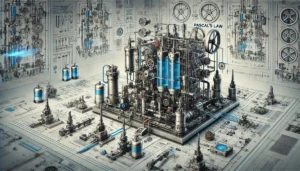Seismic Engineering is crucial for not only the designed and built environment but also for integral infrastructures such as buildings, pipelines, bridges, and power stations as it protects them against adverse impacts of earthquakes. It is important to clearly mention, however, that the most damaging earthquakes are those that generate ground motions and vertical and rotational movements that tend to be uncontrolled and uncontained. Ground motions are quite destructive and may lead to complete collapse or total operational breakdowns in badly designed systems. By assessing the possible risks integrated within the built environment, seismic engineering applies contemporary technologies alongside advanced engineering principles to minimize the risk of sustaining damages to the built environment which otherwise would continue to function safety and smoothly even after an earthquake.
The sub-article will essentially discuss how civil structures such as facilities and pipelines shall over the course of time withstand earthquakes, including plumbing.
What Are Seismic Forces
Earthquakes Shake Buildings And Placem into The Ground in a Vertical and Rotational Motion. Slow Motion But Strong Enough to Do Large Scale Damage. Failure of Older Buildings That Have Not Been Upgraded is A Serious Concern. Look out for Sway, Vibration and Other Seismic Motions. All of these Consequences Could Lead to a Large Scale Collapse of Said Building. Key Difficulties Include:
Dynamic Loads: Earthquake Shakes The Ground for Longer than Usual Time Then Returns Back To Its Stillness. Very Difficult to Predict, Its Frequency And Its Duration
Soil-Structure Interaction: If The Structure is Buried Underwater or in Soil than The Liquefaction Of Soil Lessons A Sets of Problems.
Resonance Impacts: If the ground shaking is in tune with the structure’s natural frequency then amplification of its motion through resonance makes it more susceptible to failure.
Engineering Of Facilities Against Seismic Activity
Design Principles that are Flexible
Seismic engineering practices are such that they account for flexibility in structural design rather than putting too much emphasis on the rigidity of the structure. The goal is in fact to form structures that would bow or bend so as to absorb energy during an earthquake rather than completely dispersing that energy. Particular items include:
Systems for Structural Isolation: To reduce the forces that are transmitted to the structure, flexible bearings or pads are placed in between the structure and its foundation which help in dissipating seismic energy.
Devices which Absorb Motion: Such as tuned mass dampers or viscous dampers. They minimize motion of the structure and bring about stabilization of the structure by these energy dissipation devices.
Shear Walls and Braced Frames: These structures augment lateral protection of the building from over oscillation and distortion.
Material Choices
For a structure to be seismic resistant, the choice of its materials must be suitable. Although various materials can be adopted, structural steel and concrete are widely used in practice due to their mechanical properties including high ductility which is the capacity to deform under stress without undergoing fracture. Other materials available include advanced ones such as fibre composites that provide further enhancement in flexibility and strength.
Zoning and Codes
Seismic codes are in place for the construction of facilities depending on the seismic risk of an area. An example would be construction in places that are high risk like California or Japan which has their stringent requirements for incorporating safety factors and redundancy requirements in the designs.
Critical Facilities
Some structures such as hospitals, power plants, and data centers cannot be allowed to go down at the time of disasters or emergencies therefore they need a higher seismic protection. Their designs often include, redundant and back up systems, back up systems, and monitoring systems to manage risks.
Seismic Engineering for Pipelines
Considering their length, embedment and dependence on buried soil, pipelines can be considered extremely susceptible to seismic activity. In the case of seismic engineering, it has measures for dealing with the interaction of pipeline movement with the soil, piped soil condition and soil housed earth monitored by flexible structure.
Flexible Joints and Expansion Loops
Expansion loops and other movement joints of the expansion joints included in the design of the pipelines are intended to accommodate the pipe stresses due to ground displacements. These features enable the pipes to flex, bend and adjust themselves without breaking.
Material Strength and Ductility
Seismic resistant pipelines are put together using composite materials and steel of high strength. Materials used do not only endure stress but can also diffuse shape changes.
Buried Pipelines and Soil Stabilisation
The outcomes of the work show that we have to take into account the soil behaviour which saturates when an earthquake occurs, that barely if at all, remains plausible during or after an earthquake. As a part of seismic engineering and form of ground improvement or soil stabilisation, some techniques such as soil grouting or installing geotextiles are utilized to avoid liquefaction and settlement of soil. As the fault lines disrupt the pipeline’s continuity, segmented pipeline designs along with anchoring systems do help reduce losses.
Seismic Monitoring Systems
Specialised sensors are positioned fairly permanently along the pipelines to sense the motion and the force that bear upon them. They can provide alert for every operator in real time giving them an opportunity for effective action and avoidance of damage during the seismic event.
Real-World Applications
Base-Isolated Buildings in Japan
A large number of skyscraper structures in Japan have a system that isolates the building from the base in order to mitigate the effects of earthquakes. For example, the Tokyo Skytree, which is a prominent structure in Tokyo, employs significant engineering creativity to resist the strongest earthquakes without any damage to the building.
Trans-Alaska Pipeline System (TAPS)
This transmission line has the seismological design which considers seismic principles, including the movement of blocks since there is the Denali Fault that crosses these pipelines. Its flexibility also allows the support and sliders to shift with the earth, decreasing the probability of the line rupturing.
Chile’s Copper Mines
Thus, because it is in a strong seismic zone, exceptional seismic designs are implemented on the supporting structural elements of the mining centres central to that country as well as on the facilities that transport coal to other processing plants. These designs include vibration isolators as well as flexible pipes.
Advantages of Seismic Engineering
Increased safety: Helps in saving lives by containing the potential risk of a building collapsing during an earthquake.
Operational restoral: Commend of seismic event a functional structure with minimum restoration effort can include pipelines, hospitals and many others.
Cost efficiency and economic benefit: Lowers repair costs and decrease downtime hence saving a lot of money in the long run.
Reducing environmental factors: Helps to reduce the effects of hazardous materials escaping into the environment along with the breaking down of infrastructure.
Disadvantages of Seismic Engineering
Finances: Spending on a seismic protective system can increase building expenses which is not suitable for developing projects.
Lack of understanding: There are a variety of earthquake movements so there is a need for enormous 3D modeling and other activities.
Old infrastructures: It becomes difficult and more expensive to alter the older buildings and pipelines to fit the modern day building standards.
Outlook of Seismic Engineering
Technology is changing the way seismic engineering is done with AI and IoT and other new materials. AI in predictive model builds seismic risk assessment with a higher accuracy than previous versions. IoT is facilitating real time structural performance and changes monitored systems that further enhance projects. Self-healing materials alongside other innovations are putting up a sturdy building that will withstand the test of time.
Conclusion
The work of a seismic engineer is of paramount importance for the protection of key buildings and structures in the event of an earthquake. Using flexible design, new materials and modern technologies, the engineers are able to make sure that structures and pipelines are safe, operational, and outlast the test of time. In light of the increasing seismic risks targeted at subsystems around the globe, the development within seismic engineering tend to assign the tasks of common outages and saves lives and processes and economies.










